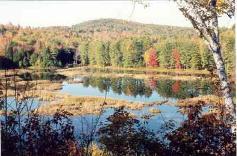|
-- What is a Natural Resource Inventory?
-- Why is a Natural Resource Inventory Important?
-- Natural Resource Inventory - Phase I
-- Contacts for more information
-- Resources used for NRI - Phase I
What is a Natural Resource Inventory?
A Natural Resource Inventory (NRI) is composed of listings and descriptions of naturally occurring resources in a community. An NRI generally includes:
- Inventory maps which show the location and extent of important resources such as farmlands, groundwater resources, significant wildlife habitats and other related items.
- A database of information which defines and documents the visual information displayed on the maps. This database provides the factual basis for resource management and land planning decisions.
- A narrative summary which describes the NRI goals, summarizes the findings of the inventory, and details the methods used to evaluate the results. A narrative may also include specific conservation concerns which require action by the community.
Why is a Natural Resource Inventory important?
A Natural Resource Inventory (NRI) will help us manage our future.
- An NRI will define the resources we have and allow the community to select those which are essential to our identity and which deserve special preservation efforts.
- An NRI will quantify the undeveloped land we have so we can more accurately project the effects or our current planning and zoning regulations and adjust them if we need to.
- With the input of our residents, an NRI will help set priorities for the use of Town resources in our conservation efforts.
- An NRI will take a snapshot of our community environment which we can use as a baseline for evaluating the impact of future growth.
The completed inventory provides information that will support careful land use planning, voluntary land conservation, and improved resource protection measures. (Auger & McIntyre, 1992) An NRI is not the end of our efforts; it is the beginning.
Natural Resource Inventory - Phase I (May, 2007)
The Natural Resource Inventory - Phase I supports three goals of the NRI Steering Committee:
- It summarizes Plainfield data available from local, state and national sources and presents it to the Community in writings, charts and maps.
- It identifies areas where further information is needed and recommends processes for gathering the additional data.
- It provides a vehicle for generating further community interest in this project and for soliciting input from Town boards and committees and from the community at large.
The Phase I Inventory includes the following maps along with written and graphic explanations of their significance:
- Plainfield Base Map (316kb)
- A map showing roads, basic topography, surface waters and conserved lands.
- Agricultural Resources
- Land which has been identified by the US Department of Agriculture as having the greatest potential for agricultural production.
- Conserved and Public Lands
- Lands on which development is prohibited as a result of Town ownership, private ownership by conservation groups, or existing conservation easements.
- Groundwater Resources
- Aquifers and public well sites in Plainfield.
- Potential Contamination Sites including gravel pits
- Unfragmented Lands
- Large blocks of undeveloped land which sustain diverse communities of plant and animal species.
- Surface Waters and Watersheds
- Streams and water bodies in Plainfield and the contiguous land areas which feed them.
- Wetlands
- Wetlands in Plainfield as identified by the US Fish and Wildlife Service’s National Wetlands Inventory and by the hydric soils identified on the USDA Natural Resource Conservation Service’s soils map.
- Co-occurence of resources
- A co-occurence map shows the combined impact of having a number of resources in the same geographic area.
Finally, this inventory represents the beginning of an on going delineation of the natural resources in Plainfield. We hope the information which follows will lead to a better understanding of the natural resources in our community and will generate discussion and debate about the importance of these resources to our future. The Steering Committee looks forward to receiving community input to help us set priorities for the continued development of the Natural Resource Inventory.
Contacts:
If you have questions or need additional information, please contact:
|
David Grobe, Chair
Plainfield Conservation Commission
675-5550
|
Mike Sutherland, Chair
Natural Resource Inventory Steering Committee
675-2101
Plainfield_NRI@comcast.net
|
Resources:
The Natural Resouce Inventory Steering Commitee wishes to acknowledge the following resources.
|



